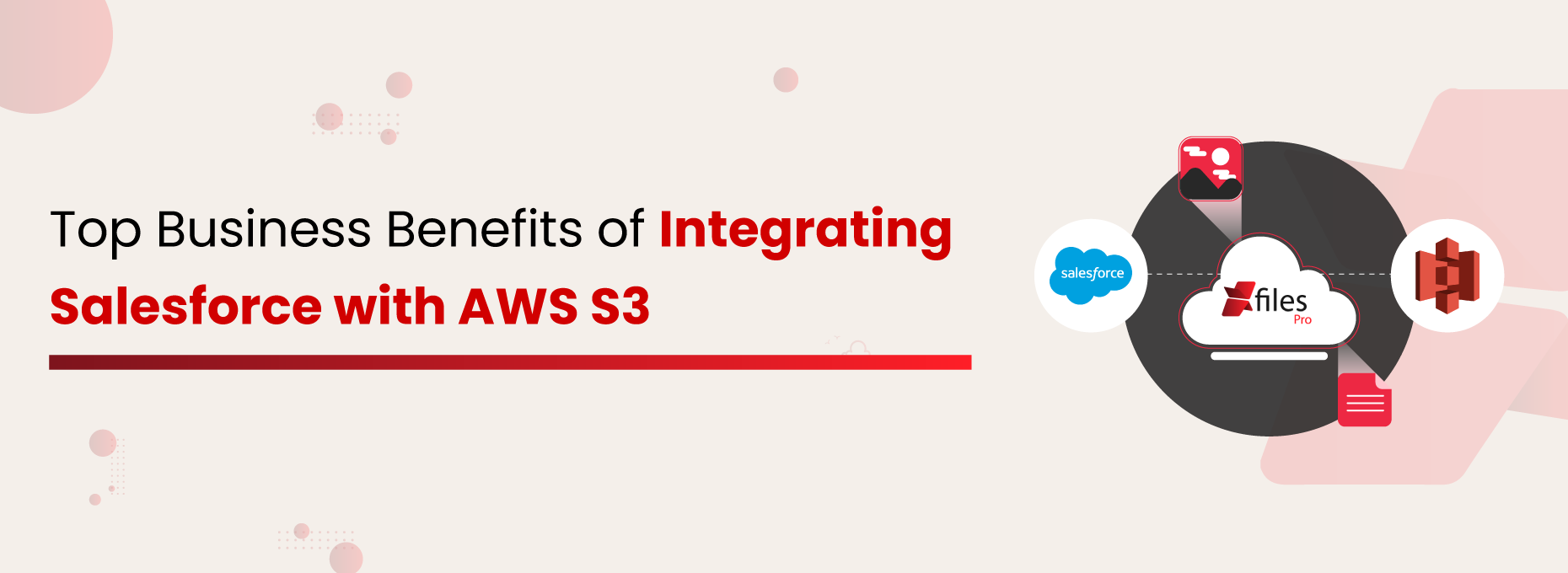Ritika
Enterprises today generate—and need to retain—massive volumes of documents: quotes, contracts, invoices, design files, emails, support attachments, and more. However, Salesforce’s native file storage is both costly (starting at $5 per GB/month) and limited (10 GB + 2 GB per license). AWS S3, by contrast, offers pay‑as‑you‑go pricing (as low as $0.023/GB/month) and virtually infinite scale. The benefits of integrating Salesforce with AWS S3 are significant: you get seamless access inside Salesforce along with cost‑effective, secure external storage. Below, we unpack eight strategic advantages and real‑world examples of this powerful pairing.
An Overview of Salesforce–S3 Integration
At its core, integrating Salesforce with AWS S3 creates a seamless bridge between your CRM’s metadata layer and Amazon’s scalable object storage. Here’s how it works:
Metadata vs. Binary Storage
Salesforce continues to manage all file metadata—names, record links, sharing rules, and version histories—so users never lose the native Salesforce experience.
AWS S3 becomes the system of record for the actual binary data (PDFs, images, videos), storing files in buckets organized by your business logic.
Connector Patterns
Real‑Time Offload: A file is immediately moved to S3 the moment it’s uploaded in Salesforce. Ideal for use cases that require instant access in both environments.
Scheduled Batch Sync: Files accumulate in Salesforce throughout the day and are moved to S3 in off‑peak hours, optimizing API usage and reducing daily call volume.
Hybrid “Hot/Cold” Model: Frequently accessed (“hot”) files stay in Salesforce for performance; older (“cold”) files are archived to S3, then retrieved on demand.
Security & Permissions Enforcement
When a user requests a file in Salesforce, the connector verifies their Salesforce permissions, then generates a secure, time‑limited S3 URL behind the scenes, ensuring you never expose your S3 bucket to the public internet.
Bidirectional Sync & Conflict Handling
Changes made to files in S3, such as updates via external apps or version uploads, can be propagated back to Salesforce, with built‑in rules for version control and conflict resolution.
Top 8 Benefits of Integrating Salesforce with AWS S3
Significant Cost Savings
Enterprise‑Grade Security & Compliance
AWS S3 provides robust encryption (SSE‑S3, SSE‑KMS), fine‑grained IAM and bucket policies, and immutable versioning or object‑lock options. Combined with Salesforce’s role‑based sharing settings, this ensures that your sensitive documents meet GDPR, HIPAA, SOC 2, and other regulatory mandates without custom development.
With XfilesPro’s added security and encryption features, you can easily improve the existing security features of files that you move from Salesforce to AWS S3.
101 Ways to Use XfilesPro (Popular Use Cases)
Centralized, Metadata‑Driven File Management
Integrating with S3 lets you build dynamic folder structures and tags based on Salesforce record data, Account IDs, Opportunity stages, Case numbers, and more. This metadata‑driven approach means every file lives in a predictable place, searchable from within Salesforce yet physically organized in S3.
XfilesPro for Smarter Salesforce Document Management with Structured Folders
Infinite Scalability & High Performance
AWS S3 scales from gigabytes to exabytes without any manual intervention, so you never worry about hitting storage limits. Features like multipart uploads and Transfer Acceleration ensure large files are ingested and served quickly to users around the globe.
Seamless Data Accessibility
Users continue to access, preview, and share files directly inside Salesforce, but those files now reside in S3. The connector transparently generates secure, time‑limited URLs, giving teams the same in‑app experience while tapping into S3’s reliability and global distribution.
Advanced Analytics & AI‑Driven Insights
With files in S3, you can catalog them via AWS Glue, query usage logs with Athena, or run machine‑learning models in SageMaker, uncovering patterns in document access, automating classification, or even extracting insights via OCR and natural‑language processing.
While you need to configure AWS Glue, Athena, SageMaker, or similar to do ML, OCR, or large‑scale queries, XfilesPro supports your efforts by making all the necessary files accessible in a single place.
Voice‑Enabled & Conversational Experiences
By pairing S3 with AWS Lex or Alexa for Business, you can build voice commands that fetch Salesforce‑linked documents on demand. Field reps can ask for the latest contract PDF or compliance checklist hands‑free, boosting productivity in mobile or remote scenarios.
Enhanced Collaboration & Version Control
S3’s object versioning and object‑lock features protect against accidental overwrites or deletions, while integrations with tools like Amazon WorkDocs enable real‑time co‑editing. Every revision is stored immutably, making audit trails and legal holds both simple and reliable.
How XfilesPro Delivers on Salesforce-S3 Integration Benefits
XfilesPro transforms Salesforce–AWS S3 integration by automating policy‑driven offloads in real-time or scheduled batches, ensuring you only pay AWS storage rates.
Its metadata‑aware folder engine maps Salesforce fields to S3 paths and tags, creating predictable, organized buckets without custom code.
Bi‑directional sync with conflict resolution propagates updates between environments, while permission mirroring generates secure, time‑limited S3 URLs based on Salesforce sharing settings.
Policy‑based lifecycle controls automate tiering to Glacier or purging outdated files, meeting retention requirements effortlessly.
Users can email attachments to dedicated aliases for auto‑capture in S3, and branded external‑sharing portals leverage pre‑signed URLs under existing permission models.
A rich API and Flow actions enable seamless extensions, OCR, image resizing, or custom automation, without engineering overhead.
Out‑of‑the‑box dashboards and audit logs surface usage, security events, and transfer metrics, giving IT and compliance teams full visibility.
Conclusion
- Assess Your Current Storage: Identify “hot” vs. “cold” files and estimate cost savings.
- Choose Your Integration Pattern: Real‑time, scheduled, or hybrid.
- Pilot with XfilesPro: Spin up a proof‑of‑concept in a sandbox.
- Roll Out & Automate: Leverage lifecycle rules, tags, and workflows.
- Measure & Optimize: Track your savings, compliance posture, and user adoption.



